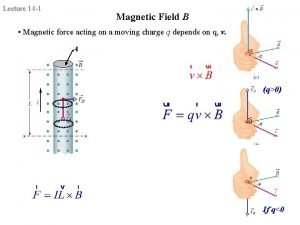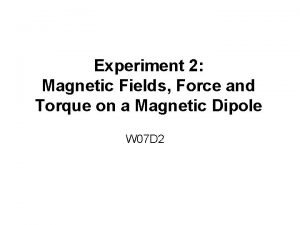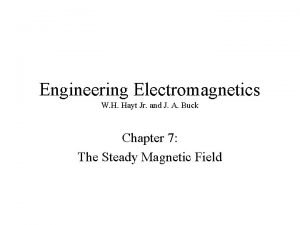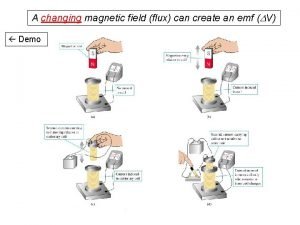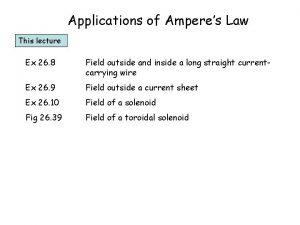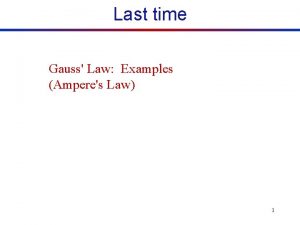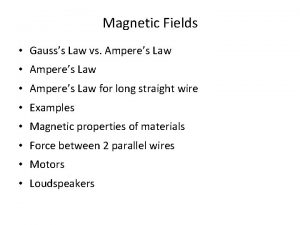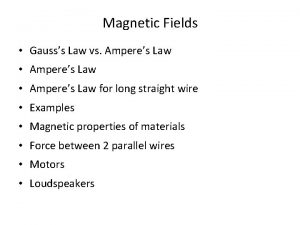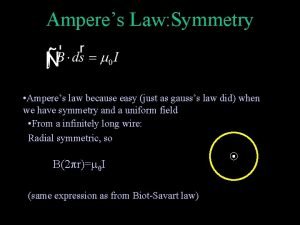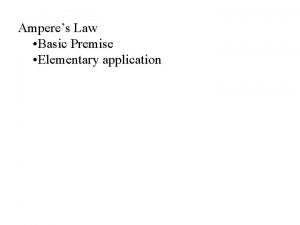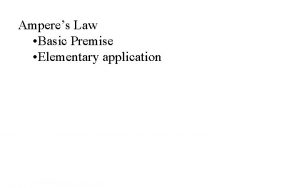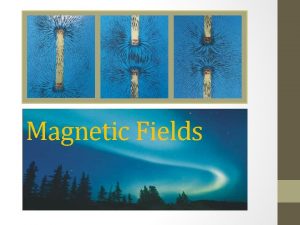Amperes Law Magnetic Field Loop A closed loop

![Magnetic Field Loop ] A closed loop can be drawn in a magnetic field. Magnetic Field Loop ] A closed loop can be drawn in a magnetic field.](https://slidetodoc.com/presentation_image_h2/af511afa4d8ed6d496b758b7c44a9e4f/image-2.jpg)
![Current Through Loop ] The loop can be broken down into separate segments Dl. Current Through Loop ] The loop can be broken down into separate segments Dl.](https://slidetodoc.com/presentation_image_h2/af511afa4d8ed6d496b758b7c44a9e4f/image-3.jpg)
![Ampere’s Law ] The sum of the parallel fields is based on the field Ampere’s Law ] The sum of the parallel fields is based on the field](https://slidetodoc.com/presentation_image_h2/af511afa4d8ed6d496b758b7c44a9e4f/image-4.jpg)
![Application to Line B I ] Apply Ampere’s law to a straight line current Application to Line B I ] Apply Ampere’s law to a straight line current](https://slidetodoc.com/presentation_image_h2/af511afa4d8ed6d496b758b7c44a9e4f/image-5.jpg)
![Solenoid Current ] For a field inside the solenoid use four straight lines to Solenoid Current ] For a field inside the solenoid use four straight lines to](https://slidetodoc.com/presentation_image_h2/af511afa4d8ed6d496b758b7c44a9e4f/image-6.jpg)
![Solenoid Field ] For a field inside the solenoid use four straight lines to Solenoid Field ] For a field inside the solenoid use four straight lines to](https://slidetodoc.com/presentation_image_h2/af511afa4d8ed6d496b758b7c44a9e4f/image-7.jpg)
![Solenoid Match ] Ampere’s law can be applied to compare the current and the Solenoid Match ] Ampere’s law can be applied to compare the current and the](https://slidetodoc.com/presentation_image_h2/af511afa4d8ed6d496b758b7c44a9e4f/image-8.jpg)
- Slides: 8

Ampere’s Law
![Magnetic Field Loop A closed loop can be drawn in a magnetic field Magnetic Field Loop ] A closed loop can be drawn in a magnetic field.](https://slidetodoc.com/presentation_image_h2/af511afa4d8ed6d496b758b7c44a9e4f/image-2.jpg)
Magnetic Field Loop ] A closed loop can be drawn in a magnetic field. B I • Any shape path • Include direction along path ] Ampere deduced a relationship between the loop and currents.
![Current Through Loop The loop can be broken down into separate segments Dl Current Through Loop ] The loop can be broken down into separate segments Dl.](https://slidetodoc.com/presentation_image_h2/af511afa4d8ed6d496b758b7c44a9e4f/image-3.jpg)
Current Through Loop ] The loop can be broken down into separate segments Dl. ] The field parallel to an individual segment is B║. • Opposite to loop direction is negative ] The net current is the sum of all currents into the loop. • Out of loop is negative
![Amperes Law The sum of the parallel fields is based on the field Ampere’s Law ] The sum of the parallel fields is based on the field](https://slidetodoc.com/presentation_image_h2/af511afa4d8ed6d496b758b7c44a9e4f/image-4.jpg)
Ampere’s Law ] The sum of the parallel fields is based on the field direction on the perimeter of the loop. ] The sum of the currents is based on the area within the loop. ] Ampere’s law states that these sums are equal.
![Application to Line B I Apply Amperes law to a straight line current Application to Line B I ] Apply Ampere’s law to a straight line current](https://slidetodoc.com/presentation_image_h2/af511afa4d8ed6d496b758b7c44a9e4f/image-5.jpg)
Application to Line B I ] Apply Ampere’s law to a straight line current in a wire. ] Use a loop that follows a circular field line. • B always parallel to Dl ] One current through the loop I. ] Ampere’s law gives the expected result.
![Solenoid Current For a field inside the solenoid use four straight lines to Solenoid Current ] For a field inside the solenoid use four straight lines to](https://slidetodoc.com/presentation_image_h2/af511afa4d8ed6d496b758b7c44a9e4f/image-6.jpg)
Solenoid Current ] For a field inside the solenoid use four straight lines to make the loop. ] The loop length L along the NI L axis defines the number of turns of wire in the loop. l B
![Solenoid Field For a field inside the solenoid use four straight lines to Solenoid Field ] For a field inside the solenoid use four straight lines to](https://slidetodoc.com/presentation_image_h2/af511afa4d8ed6d496b758b7c44a9e4f/image-7.jpg)
Solenoid Field ] For a field inside the solenoid use four straight lines to make the loop. NI B ] B is perpendicular to radial segments. • No contribution to sum l ] Outer segment has no field if solenoid is long enough. ] The only contribution is the inside segment.
![Solenoid Match Amperes law can be applied to compare the current and the Solenoid Match ] Ampere’s law can be applied to compare the current and the](https://slidetodoc.com/presentation_image_h2/af511afa4d8ed6d496b758b7c44a9e4f/image-8.jpg)
Solenoid Match ] Ampere’s law can be applied to compare the current and the field. NI • Independent of choice of line inside the coil B l
